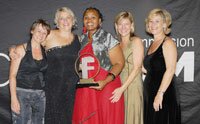imaginemag - arts & culture emagazine | mar / apr 2010 : edition 03
I SAY… Dance. Through the ages different types of dance forms have come to the fore whilst the popularity of others appears to wane. The factors that determine this pattern of events have always intrigued me.
Watching a group of B-boys rehearsing with my classically trained dancers brought these thoughts into the forefront of my mind. Why do some types of dance become popular and then lose their popularity for a period only to have some event, whether natural or contrived, drive the popularity stakes upwards again. We can all think of many obvious reasons for this: social, economic and political conditions, a very strong personality who imprints their ideas on the general public, changes and popularity of different music forms plus many more reasons. But something that struck me forcibly was the different ways these two particular dance forms, ballet and the B-boys, use space and their bodies in order to communicate. What were the reasons for this and could this way of moving have anything to do with the popularity swings? As societies become more open and less restricted in thinking do body movements follow? The influence of technology leads me to wonder – do we as dancers influence technological advancement or does technology influence our way of moving? These ideas led me to begin the process of examining other dance forms through the ages, their usage of space and communication methods.
Social conditions will always affect every aspect of our lives but we are only dealing with the effect on dance for the moment. Right back to Louis 14th in France, also known as the Sun King for his love of expensive jewel and gold encrusted clothing, the rich were empowered to develop their artistic talents because they had two valuable commodities, time and money. They were able to watch the peasants dancing and then utilise those movements, dress them up, add scenery to the play/ballet and you had a more sophisticated, refined production. The common people did not have the time or money to dedicate to their dancing as they struggled to work simply to survive. This did not stop them enjoying their dancing and being innovative, however it also did not prevent the results of their endeavours being commandeered by the ruling powers for their own benefit. Nothing changes does it!
In the first half of the 1900s with the advent of Diaghilev and the Russian dancers, ballet received great attention and acclaim in England, Europe and America when they performed in these countries for the first time. The sets, the costumes, the choreography and of course the glamour of the dancers, Pavlova, Nijinsky, Karsavina to name a few all created excitement and interest was much stimulated wherever they performed. A whole new generation of dancers were stimulated to ever greater heights of technical prowess after watching the `Russians’. Nureyev and Baryshnikov’s explosion onto Western Europe’s theatre stages had a similar effect on the interest and development of ballet.

What was it that caused tap dancing to become so popular and spawn such greats as Fred Astaire, Ginger Rogers and Gene Kelly in the 1930s – 1970s? Was it their excellence that was solely responsible for this phenomenon? Did technology and the development of the film industry have much to do with it? Gene Kelly revolutionised the film industry by finding new ways of filming dance and thus extending and adding interest to the dancing scene. Was this interest in the dance for film created because film makers saw a way of adding something new to the film genre? When their personal star waned did the art form lose it’s appeal?
Why are hip hop and B-boys currently popular forms of dance? Was it a purely a social trend driving the spreading of the culture of street dancing? Or did someone see an economic opportunity with the music, the clothing etc. Or is it simply mankind’s makeup to be forever in pursuit of something new and something different? And when this meets with mass media marketing and promotion we have a new trend. But will it have lasting impact? Only time will tell.
Another very big factor is if business or the political powers can see a profit in assisting and developing the art form for its own business growth potential. Think of cycling and running and how big business sponsors have come forth to assist and create and fund events. A few years ago it was tennis. And guess what? All the equipment, clothing extra goodies required are all sold by these businesses. Cycling, athletics and selected sports have been developed in a large part into the culture of this country based on business, political and social interests. And let us not think about Soccer and what has been spent and for what purpose? Come on dance people get wise! Let us creatively sell our cultural abilities.
But back to the dance forms. How much of where we dance impacts on what we dance? If you have to dance in a small space obviously traveling steps are not much of an option so the steps become smaller and more focused. Working in a large area with high ceilings on a well sprung floor will encourage large steps involving travel and the use of involved floor patterning. So like the chicken and the egg which comes first the movement or the space?
With a good command of a language and a wide vocabulary one can communicate many ideas, feelings, thoughts and stories. Think what happens when you are in a foreign country. Suddenly you are using very exaggerated arm movements and facial expressions to make up for your lack of words and grammar.
Watching these B-boys I was fascinated how they each individually explored what their bodies could do in the space they found themselves in. Lacking a grammar of dance or movement form from which to start they had to create their movements from within themselves, but based on messages they were receiving, in this case, from me and the storyline I was following.
I think the survival of different dance forms is determined to a large extent, like a language, on the development of its grammar and the ability that it has to adapt to changing times and requirements of the country it finds itself in. Some dance forms have taken the basic ballet grammar and used that as a starting point for developing different ways of moving just as certain languages were once offshoots of Latin which is a root language now and not the living language it once was. Had there been no root language how would the spoken and written word have developed? A number of dance initiatives have attempted to create their own language of movement to create something different. I am not sure how successful this has been. I am judging or assessing success in this case as survival and prospering in a meaningful manner over a lengthy period of time and not only in one person’s lifetime.
I started off thinking that whilst the grammar of dance and the grammar of a language had many similarities dance was nevertheless different because our bodies are our instruments. But when you consider that when one speaks one uses various parts of the anatomy and when one dances one uses the whole body and that bodies generally function according to a similar manufacturing design is there a difference? Letters in the alphabet correspond to movements in dance. Combining selected letters creates words and combining selected movements one creates steps. These words or movements are used to impart a story, an idea, an emotion. What happens after that is the difference between the writing of Solzhenitsyn and Enid Blyton and in the dance field between the great classical ballet Giselle and the great musical West Side Story.

Amy Gould is a Fellow of the Imperial Society of Teachers of Dancing. She is the principal and owner of her full time ballet school, director and choreographer of her dance company Dance Crew, owner/manager of Tokai On-Main a 100-seater intimate theatre and editor in chief of ImagineMag!

01 / opening of the fugard theatre in cape town:
On 12 February 2010 when the Fugard Theatre’s doors were officially opened an emotional Fugard was there to receive the keys of the new theatre, alongside Producer Eric Abraham, Artistic Director Mark Dornford-May and Theatre Patron Minister Trevor Manuel. Read the full story...
02 / robben island - a world heritage site:
These days visitors to Cape Town make a beeline to the gateway at the Victoria and Alfred Waterfront from where they can catch a boat ride to the iconic Robben Island. This small Island, at the entrance to Table Bay, has gone from a place of punishment, Leper Colony back to a place of punishment and now known world wide for its history of approximately the last 35 years. Mention the name Nelson Mandela, South Africa’s first democratic president and immediately Robben Island comes to mind. Visitors wish to see the cell in which he was kept, where he worked out doors, what his relationship was with other political prisoners and the Island’s prison staff. Read the full story...

03 / spier contemporary 2010, an interview with
chris swift and time on our hands exhibition:
The winners of the Spier Contemporary 2010 Competition were announced at the City Hall launch on 13 March 2010 in Cape Town. Read the full story...
04 / dr van der ross:
Recently Dawn and I were invited to the launch of Dr Van Der Ross’s latest book. Our connection with him has been over many years and in different ways. Read the full story...
05 / how humans define themselves:
At times, it seems the usage of the word culture takes on rather vague interpretations. A speaker may use it to defend a weak argument or a point of view and when on the losing end and wishing to save face will say, “well that is my culture”, probably feeling that it is a point that cannot be proven one way or the other. Read the full story...

06 / the singer:
“If music be the food of life, I’d eat my piano” says Denzil M Thorneusic. Read the full story...
07 / the role of music in cultural life:
Music, in its various forms, can stir human emotions to varying degrees of rapture as well as exciting and stretching the intellect. However, it has another use or ability and that is in helping to spread opinion and principles especially to effect change or reform. As an example consider the chorus ‘Va Pensiero’ from the opera Nabuco by the Italian composer, Giuseppe Verdi. Read the full story...

08 / film in cape town:
A resounding ‘Yes’ to the film industry in Cape Town as the City hosted its very own film industry ‘Oscars’. Over the past 12 months Cape Town has once again cemented its place as one of the leading film industry production destinations in the World. This was the core message that emanated from the 2nd Annual Cape Film Industry’s Imbongi Awards which was held on Saturday, 6th March 2010, at the CTICC. Read the full story...
09 / 2009 provincial arts & culture awards, western cape:
2009 Provincial Arts and Culture Awards in the Western Cape, South Africa. ImagineMag! extends congratulations to the recipients as well as to the artists who were chosen to create highly personalised and creative awards for the individual recipients. Read the full story...
edition. 03 contributors
Larissa Fainberg is a freelance arts and culture writer living in Johannesburg, with a particular interest in the dynamic, up and coming visual arts scene which South Africa has to offer. She has a BA Humanities in History of Art and Philosophy from The University of the Witwatersrand.
Dawn Gould (D Litt et Phil), owns and runs FACTS FOUND an historical research bureau situated in Cape Town, South Africa.
For further details see factsfound.isat.co.za

